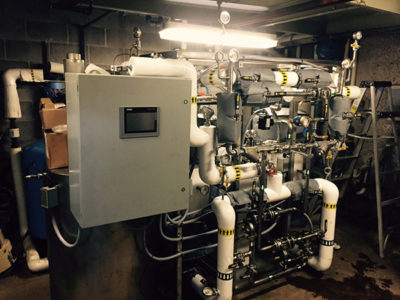Project highlights and product features
- Demonstrated ability to consistently treat 1,4-dioxane to less than 0.2 µg/L detection limits or lower, meeting all current and proposed treatment standards
- Consistent and predictable treatment, independent of changes in influent concentrations and flow rate
- System simplicity allows rapid installation and requires limited operator oversight
- Improved compliance performance at a lower life- cycle cost
- No impact to supply water mineral content
- In place regeneration media can be cycled thousands of times with no loss in adsorption capacity or the ability to reliably achieve low-level effluent
Rapid response capability to address the challenge of 1,4-dioxane contamination
 Emerging contaminants like 1,4-dioxane pose unique challenges to hospitals, whose sensitive patient populations require high levels of protection from unwanted compounds. At this confidential health care institution, ECT2 was asked to respond quickly with a proven treatment technology that would not only mitigate 1,4- dioxane impacts to water used in mineral baths while sustaining the facility’s operations, but also enhance their relationships with regulatory authorities and the community.
Emerging contaminants like 1,4-dioxane pose unique challenges to hospitals, whose sensitive patient populations require high levels of protection from unwanted compounds. At this confidential health care institution, ECT2 was asked to respond quickly with a proven treatment technology that would not only mitigate 1,4- dioxane impacts to water used in mineral baths while sustaining the facility’s operations, but also enhance their relationships with regulatory authorities and the community.
ECT2 deployed a modular treatment package to address the hospital’s need for a point-of-use, on demand water treatment system. Based on a modular design, the system is efficient, effective, and well suited for removing 1,4-dioxane and a broad range of other organic contaminants.
The treatment system provided for this application is a reduced capacity version of the M25 unit (M25 is a scalable version of a standard ECT2 design with a nominal capacity of 25 gallons per minute). ECT2 fabricated and delivered the skidded system in 14 weeks, meeting the facility’s requirement for rapid delivery and reliable long-duration operation.
How synthetic media works
Synthetic media has an affinity for 1,4-dioxane and other organic compounds allowing direct aqueous treatment, much like a water softener. The simplicity of this adsorption mechanism allows 1,4-dioxane and other organic contaminants to be removed directly from groundwater more reliably than competing technologies.
Synthetic media capacity is renewable in place using simple regeneration methods, allowing sustained media reuse—unlike granular activated carbon, which is unable to reliably achieve stringent treatment requirements for 1,4-dioxane and must be reactivated off site.
In other words, synthetic media’s simplicity can be likened to that of a sponge—attracting organic contaminants without requiring stripping, mass transfer or chemical reactions, while maintaining its ability to be cleaned in place and reused indefinitely.
The M25 product line and scaled versions such as that deployed for this project can be on site and ready for operation in as little as 16 weeks, providing an immediate tool for mitigating the impacts of solvents and 1,4-dioxane contamination.